Engagement Ring - In Progress
Setting
Stone
Purchase any Engagement Ring and receive a $250 Gift Card for your Wedding Band. Ends soon.
Deepen the well of love in the world.
We guarantee that every single purchase directly impacts one person's life by giving them access to clean water.
A “fancy” colored diamond is any diamond color not in the “normal color range,” also known as the D-Z scale. What is the D-Z scale? The D-Z normal color range begins at colorless (like water) and continues through to light yellow or brown. So, any diamond that falls outside that range is “fancy.” This can mean that a fancy diamond is simply a darker shade of yellow (sometimes referred to as “canary”) or brown (also known as “Champagne”). However, what most people think of as “fancy” are diamonds that are a completely different color all together! This can include lush green, vibrant purple, exotic orange – literally any other color you can think of! When a diamond falls outside the “normal” color range, it is described by its color. So, for example, a purple diamond would be called a “fancy purple.”
Diamonds naturally come in every color of the rainbow (yep red, blue, green, purple, pink, etc.), as well as black, brown, gray, and white. There are even “salt and pepper” diamonds that look more polka-dotted. So, there are many different color diamonds! Some colors, such as red and blue, are much more rare than others. As a result of this rarity, these colors are much more expensive. On the other hand, less rare colors, such as champagne and black diamonds, can be much more affordable. So, selecting a fancy diamond for your colored diamond engagement ring may not be as crazy as you thought! Truly, for every different color you can imagine, there is probably a fancy color diamond in the world that shade.
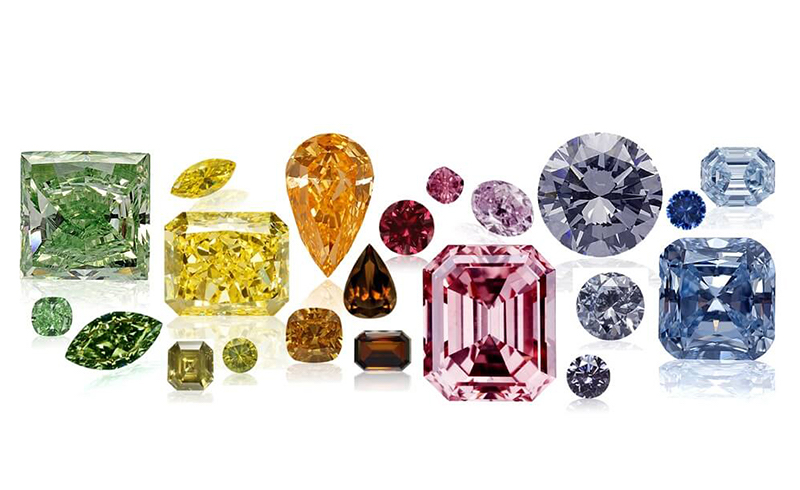
They sure are! Fancy color diamonds grow in the Earth, and we also grow real fancy color diamonds in labs! Diamonds get their color from the unique conditions in which they form. These specific conditions are so unique that only 1 in every 10,000 natural diamonds is fancy! Because this just isn’t enough to keep up with the demand for fancy diamonds, gem scientists also now create fancy diamonds in labs, too. The conditions these scientists create actually mimic the unique environments required to form a fancy diamond in the Earth’s crust!
Lab-created fancy diamonds have the exact same mineral makeup, as well as the same appearance, as natural fancy diamonds. For example, both natural and lab blue diamonds can be vivid or more grey, and they both get their color from boron. As a result, both the natural and lab diamonds are, in fact, real (the FTC even says so)! Consequently, both lab and natural diamonds make great colored diamond engagement rings.
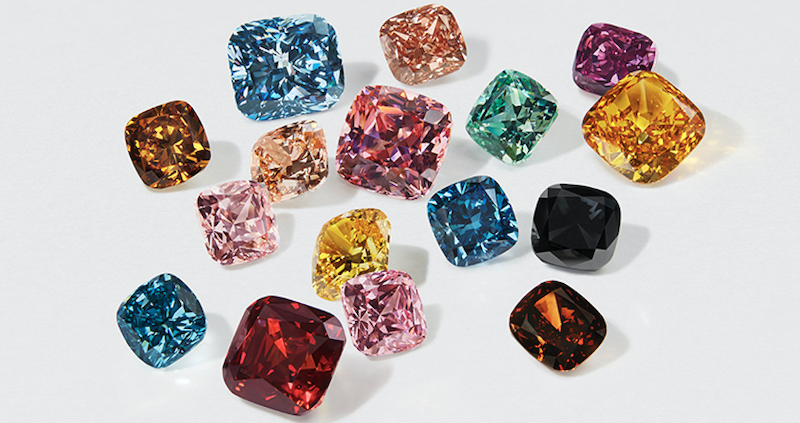
Credit: Swarovski
Not all diamonds have natural color. What I mean by that is that some diamonds get their color from treatments. For example, some “normal” color diamonds are just too yellow or brown to be conventionally pretty. So, gem scientists (safely) irradiate them to make them more attractive colors. Most frequently, these colors include blue, black, green, and yellow.
So, be alert! Always ask your jeweler if the fancy diamond you’re looking at is natural, treated, or lab-created. Do Amore informs each customer about the natural, treated, or lab-created origin of the diamond they purchase.
For the most part, yes, however, it depends on the color. Champagne, gray, salt and pepper, chameleon, and black diamonds are actually less expensive than their white counterparts! All the other colors, however, are more expensive. Just how expensive a diamond is depends upon the rarity of the diamond and how in-demand the color is at any given point in time.
Money Tip: Lab-created fancy diamonds are much less expensive than natural diamonds because gem scientists make them on demand. So, labs can control the rarity and price! I particularly love “blue nuance” and “tea rose” pink lab diamonds, which are a fraction of the price of white or other fancies. Learn more about these nuances here!
The rarest color of diamond is red. As a result, the most expensive diamond in the world is also red! This is because a diamond’s relative expense comes from its rarity and how in-demand the color is. Shockingly, there are only a handful of natural red diamonds in the entire world. Other rare and in-demand colors include blue, pink, orange, green, and purple.
Fun fact! After JLo received a pink diamond engagement ring from Ben Affleck, pink diamonds went up in value! Read about her green diamond engagement ring here.

Credit: GIA
Diamonds are born with color when unexpected things happen to their crystals. In some instances, diamond crystals absorb teeny tiny “trace elements” during formation. These trace elements are so small you can’t see them – even with magnification! For instance, if a diamond crystal absorbs nitrogen, it may turn yellow. But, if it absorbs boron, it will be blue! Natural radiation can cause diamonds to turn green, like the famous Dresden diamond. Mysterious pink diamonds have no trace elements at all, and instead, they occur when extreme stress acts upon the diamond crystal. This stress is so intense, the entire structure changes and turns pink!
Finally, scientists can also “treat” diamonds to make them colorful. Many blue, black, green, and yellow diamonds on the market today began their lives as a “normal” color, and were then irradiated. These treatments make otherwise unattractive “normal” diamonds marketable, and make fancy diamond lovers happy! Treated natural diamonds offer great value because they give you the look you want at a much lower cost.
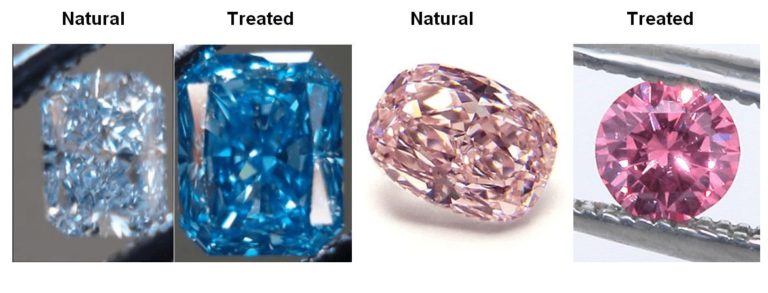
Left: Natural VS Treated Blue Diamond | Right: Natural VS Treated Pink Diamond
Natural fancy vivid red diamonds are the most valuable diamonds in the world. This is due to their incredible rarity and gem collector’s demand for them. The next most valuable diamond is fancy vivid blue (think Hope Diamond blue)!
Fancy diamonds are graded by the traditional 4Cs. But, color grading is unique! So, in addition to cut, carat weight, and clarity – we also grade fancy diamonds for what color they are (hue), as well as how vivid that color is. Also, all colored diamonds start with the word “fancy.” So, you’ll see colors like “fancy light pink” or “fancy intense orange.” Cool, huh?
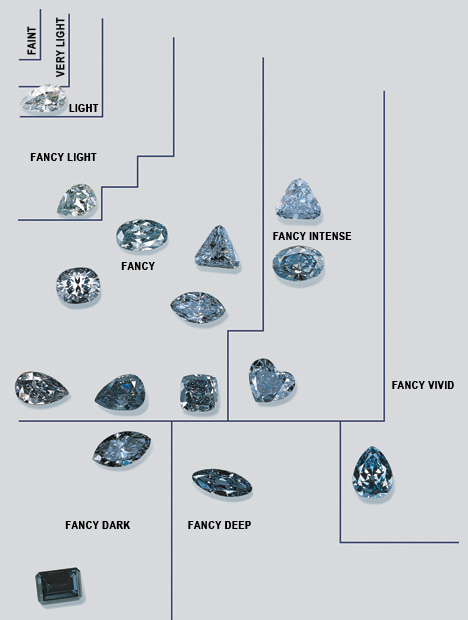
How much a diamond is depends upon its color, its lab or natural origin, and if it has undergone any treatment. In natural fancy diamonds, a stone’s value comes from its color, the pureness of that color, and how dark that color is. The first step is to determine the stone’s overall color and how rare it is. For instance, pink diamonds are more rare and valuable than yellows. The second step is seeing if that color has any grey or brown tint. These modifiers lower a diamond’s value. Finally, gemologists look at how light or dark the color is. Stones with more color are more rare than diamonds with light tints!
Recently, the Pink Star diamond (a whopping 59.60 carats) was sold at auction for over $71 million! Large natural fancy diamonds are frequently individually named due to their singularity. Some famous fancy diamonds include the Hope, Tiffany, Dresden, Moussaieff Red, and the Oppenheimer Blue.
As you would expect, lab-created fancy diamonds are less expensive than natural fancy diamonds. That’s because we control the rarity! Interestingly, however, treated natural diamonds (like irradiated black, blue, and yellows) are often about the same price as lab-created stones.
| Natural Blue | Treated Blue | Lab Blue | |
| Per carat pricing | $40,000+/carat | $1,500-$4,000/carat | $1,500-$3,000/carat |
Right here! I love finding unique diamonds for our customers! I found a glamorous 1.01ct light pink diamond for a customer yesterday, and a super cool black diamond last week! Want a color in your engagement ring? Email me at care@doamore.com! My name is Corinne, I’m the gemologist!
Verifiably Ethical & Sustainable
Guaranteed 1:1 Impact
Personalized 1:1 Customer Service
handcrafted & american-made
you before us, always
Diamonds, Gemstones, & Metals
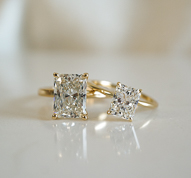
Every piece of Do Amore jewelry begins by not hurting the world. All our natural diamonds are either ethically sourced in Canada, recycled to eliminate additional demand, or accompanied by a blockchain ledger showing every hand your diamond passed through, proving your stone is truly conflict-free.
We also offer sustainable lab-created stones and guarantee all precious metals are recycled to eliminate the environmental impact of mining. Since March 2022, we carry absolutely no Russian diamonds and continue to urge the industry to follow suit.
Clean Water
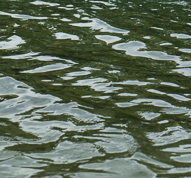
We desire to deepen the well of love in the world. We guarantee that every single purchase—whether engagement ring, wedding band, or piece of jewelry—directly impacts one person’s life by giving them access to clean water.
We do this by directly matching jewelry purchases to people in communities to ensure our funding has a one-to-one impact. We also show you the exact GPS coordinates and a photo of the water well your ring or piece of jewelry helped fund.
Customer Service
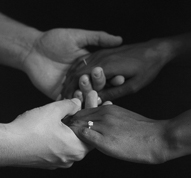
As a small, 100% founder- and employee-owned team, one-to-one encounters are at the heart of our values. Whichever way you want support throughout your engagement ring or jewelry purchase process, our team is here to accommodate you.
From high-touch to hands-off, video calls to text messages, you have our dedicated, responsive team on your side from the moment you start your search, to the day your well is built, to the time we meet again.
Engagement Rings, Bands, & Jewelry
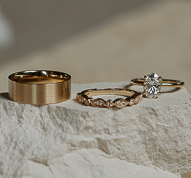
Every Do Amore design, whether one of our own or unique to you, is beautifully handcrafted in America and made specifically for you. Each ring is made to order, every time.
From classic to custom, you have the option to select from dozens of gorgeous settings or work with our design team to create something entirely bespoke. Plus, you are always covered for free inspections, polishing, cleaning, stone tightening, rhodium-plating, and resizing for life.
Our Promise
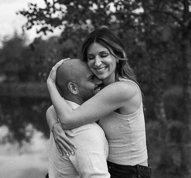
We care about what matters most to you, not what’s easiest for us. If it’s a minor change to a setting or arriving at a completely custom design, we work to ensure you get precisely what you love.
From statement-making to understated, we have options at any price point. Plus, you always have our team on your side searching to bring you every stone within your specifications. We also offer 30-day returns and a limited lifetime warranty to cover you in the rare event of a manufacturing defect.